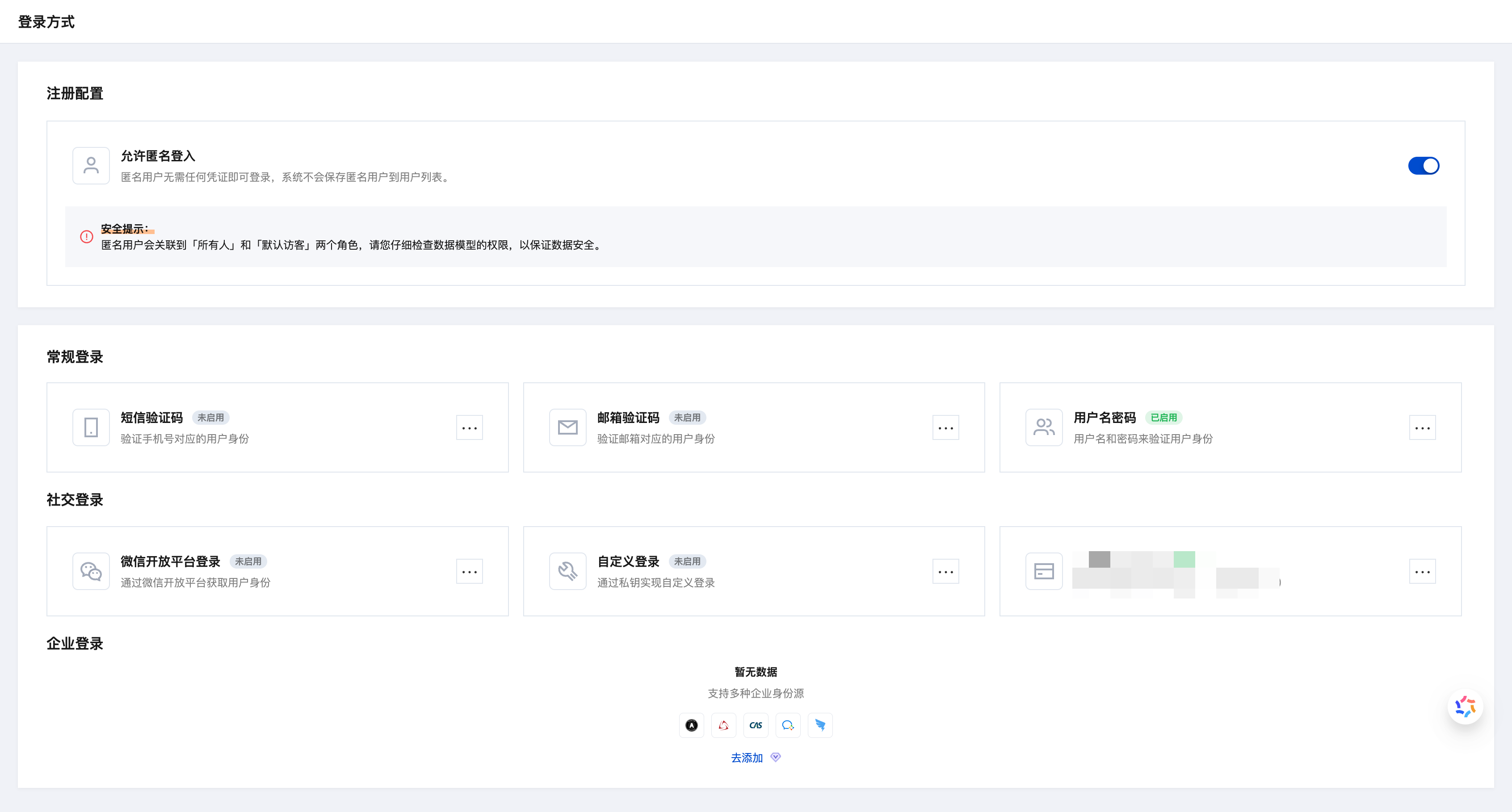Managing Login Methods
CloudBase provides multiple authentication methods, which can be flexibly configured according to your business requirements.
Enable Login Methods via the Console
First, navigate to TCB/Authentication/Login Methods and select the desired login method.

Enable Login Methods via SDK
Support for enabling and disabling login methods via Tencent Cloud SDK (tencentcloud-sdk), with compatibility for multiple languages including Java, Go, and JavaScript.
Using the Tencent Cloud SDK (tencentcloud-sdk) to enable/disable login methods will only enable the login methods for TCB platform login authentication v2 and will not simultaneously enable/disable the login methods for the legacy TCB console v1. To enable/disable v1 login methods, please go to the TCB console and perform the operation manually.
Supported login methods and parameters:
| Login Method | Parameter | Parameter Value |
|---|---|---|
| Phone number Captcha login | PhoneNumberLogin | Only supported in the Shanghai region, TRUE, FALSE, TRUE represents enable, FALSE represents disable |
| Anonymous Login | AnonymousLogin | TRUE, FALSE, TRUE represents enable, FALSE represents disable |
| Username and Password Login | UsernameLogin | TRUE, FALSE, TRUE represents enable, FALSE represents disable |
{
"EnvId": "your-env-id",
"PhoneNumberLogin": "TRUE",
"AnonymousLogin": "TRUE",
"UsernameLogin": "TRUE"
}
Sample code is provided below. For more usage examples, visit Tencent Cloud API:
- JavaScript
- Go
- Java
const tencentcloud = require("tencentcloud-sdk-nodejs-tcb");
const TcbClient = tencentcloud.tcb.v20180608.Client;
// Instantiate an authentication object. The input parameters need to include Tencent Cloud account SecretId and SecretKey. Pay attention to keeping the confidentiality of the key pair.
// Code leakage may lead to the leakage of SecretId and SecretKey, threatening the security of all resources under the account. The following sample code is for reference only. It is recommended to use keys in a more secure way. See https://cloud.tencent.com/document/product/1278/85305.
// The key can be obtained at the official console https://console.cloud.tencent.com/cam/capi.
const clientConfig = {
credential: {
secretId: "",
secretKey: "",
},
region: "",
profile: {
httpProfile: {
endpoint: "tcb.tencentcloudapi.com",
},
},
};
// Instantiate a client object for the product to be requested. clientProfile is optional.
const client = new TcbClient(clientConfig);
const params = {};
client.EditAuthConfig(params).then(
(data) => {
console.log(data);
},
(err) => {
console.error("error", err);
}
);
package main
import (
"fmt"
"github.com/tencentcloud/tencentcloud-sdk-go/tencentcloud/common"
"github.com/tencentcloud/tencentcloud-sdk-go/tencentcloud/common/errors"
"github.com/tencentcloud/tencentcloud-sdk-go/tencentcloud/common/profile"
tcb "github.com/tencentcloud/tencentcloud-sdk-go/tencentcloud/tcb/v20180608"
)
func main() {
// Instantiate an authentication object. The input parameters need to include Tencent Cloud account SecretId and SecretKey. Pay attention to keeping the confidentiality of the key pair.
// Code leakage may lead to the leakage of SecretId and SecretKey, threatening the security of all resources under the account. The following sample code is for reference only. It is recommended to use keys in a more secure way. See https://cloud.tencent.com/document/product/1278/85305.
// The key can be obtained at the official console https://console.cloud.tencent.com/cam/capi.
credential := common.NewCredential(
"",
"",
)
// Instantiate a client option (optional). Skip it if there are no special requirements.
cpf := profile.NewClientProfile()
cpf.HttpProfile.Endpoint = "tcb.tencentcloudapi.com"
// Instantiate a client object for the product to be requested. clientProfile is optional.
client, _ := tcb.NewClient(credential, "", cpf)
// Instantiate a request object. Each API corresponds to a request object.
request := tcb.NewEditAuthConfigRequest()
// The returned resp is an instance of EditAuthConfigResponse, corresponding to the request object.
response, err := client.EditAuthConfig(request)
if _, ok := err.(*errors.TencentCloudSDKError); ok {
fmt.Printf("An API error has returned: %s", err)
return
}
if err != nil {
panic(err)
}
// Output a response packet in json format string.
fmt.Printf("%s", response.ToJsonString())
}
package com.tencent;
import com.tencentcloudapi.common.AbstractModel;
import com.tencentcloudapi.common.Credential;
import com.tencentcloudapi.common.profile.ClientProfile;
import com.tencentcloudapi.common.profile.HttpProfile;
import com.tencentcloudapi.common.exception.TencentCloudSDKException;
import com.tencentcloudapi.tcb.v20180608.TcbClient;
import com.tencentcloudapi.tcb.v20180608.models.*;
public class Sample {
public static void main(String [] args) {
try {
// Instantiate an authentication object. The input parameters need to include Tencent Cloud account SecretId and SecretKey. Pay attention to keeping the confidentiality of the key pair.
// Code leakage may lead to the leakage of SecretId and SecretKey, threatening the security of all resources under the account. The following sample code is for reference only. It is recommended to use keys in a more secure way. See https://cloud.tencent.com/document/product/1278/85305.
// The key can be obtained at the official console https://console.cloud.tencent.com/cam/capi.
Credential cred = new Credential("", "");
// Instantiate an http option (optional). Skip it if there are no special requirements.
HttpProfile httpProfile = new HttpProfile();
httpProfile.setEndpoint("tcb.tencentcloudapi.com");
// Instantiate a client option (optional). Skip it if there are no special requirements.
ClientProfile clientProfile = new ClientProfile();
clientProfile.setHttpProfile(httpProfile);
// Instantiate a client object for the product to be requested. clientProfile is optional.
TcbClient client = new TcbClient(cred, "", clientProfile);
// Instantiate a request object. Each API corresponds to a request object.
EditAuthConfigRequest req = new EditAuthConfigRequest();
// The returned resp is an instance of EditAuthConfigResponse, corresponding to the request object.
EditAuthConfigResponse resp = client.EditAuthConfig(req);
// Output a response packet in json format string.
System.out.println(AbstractModel.toJsonString(resp));
} catch (TencentCloudSDKException e) {
System.out.println(e.toString());
}
}
}